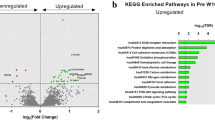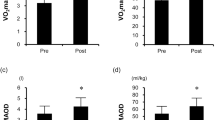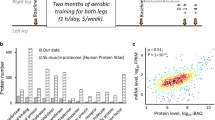Abstract
The muscle has a wide range of possibilities to adapt its phenotype. Repetitive submaximal concentric exercise (i.e., shortening contractions) mainly leads to adaptations of muscle oxidative metabolism and endurance while eccentric exercise (i.e., lengthening contractions) results in muscle growth and gain of muscle strength. Modified gene expression is believed to mediate these exercise-specific muscle adjustments. In the present study, early alterations of the gene expression signature were monitored by a muscle-specific microarray. Transcript profiling was performed on muscle biopsies of vastus lateralis obtained from six male subjects before and in a 24-h time course after a single bout of mild eccentric ergometer exercise. The eccentric exercise consisted of 15 min of eccentric cycling at 50% of the individual maximal concentric power output leading to muscle soreness (5.9 on a 0–10 visual analogue scale) and limited muscle damage (1.7-fold elevated creatine kinase activity). Muscle impairment was highlighted by a transient reduction in jumping height after the eccentric exercise. On the gene expression level, we observed a general early downregulation of detected transcripts, followed by a slow recovery close to the control values within the first 24 h post exercise. Only very few regulatory factors were increased. This expression signature is different from the signature of a previously published metabolic response after an intensive endurance-type concentric exercise as well as after maximal eccentric exercise. This is the first description of the time course of changes in gene expression as a consequence of a mild eccentric stimulus.


Similar content being viewed by others
References
Awede B, Thissen J, Gailly P, Lebacq J (1999) Regulation of IGF-I, IGFBP-4 and IGFBP-5 gene expression by loading in mouse skeletal muscle. FEBS Lett 461:263–267
Baar K, Esser K (1999) Phosphorylation of p70(S6k) correlates with increased skeletal muscle mass following resistance exercise. Am J Physiol 276:C120–C127
Bamman MM, Shipp JR, Jiang J, Gower BA, Hunter GR, Goodman A, McLafferty CL Jr, Urban RJ (2001) Mechanical load increases muscle IGF-I and androgen receptor mRNA concentrations in humans. Am J Physiol Endocrinol Metab 280:E383–E390
Bickel CS, Slade J, Mahoney E, Haddad F, Dudley GA, Adams GR (2005) Time course of molecular responses of human skeletal muscle to acute bouts of resistance exercise. J Appl Physiol 98:482–488
Carlsson AM (1983) Assessment of chronic pain. I. Aspects of the reliability and validity of the visual analogue scale. Pain 16:87–101
Cascone PJ, Schwartz LM (2001) Post-transcriptional regulation of gene expression during the programmed death of insect skeletal muscle. Dev Genes Evol 211:397–405
Chen YW, Hubal MJ, Hoffman EP, Thompson PD, Clarkson PM (2003) Molecular responses of human muscle to eccentric exercise. J Appl Physiol 95:2485–2494
Clarkson PM, Hubal MJ (2002) Exercise-induced muscle damage in humans. Am J Phys Med Rehabil 81:S52–S69
Dapp C, Schmutz S, Hoppeler H, Fluck M (2004) Transcriptional reprogramming and ultrastructure during atrophy and recovery of mouse soleus muscle. Physiol Genomics 20:97–107
Eliasson J, Elfegoun T, Nilsson J, Kohnke R, Ekblom B, Blomstrand E (2006) Maximal lengthening contractions increase p70 S6 kinase phosphorylation in human skeletal muscle in the absence of nutritional supply. Am J Physiol Endocrinol Metab 291:E1197–E1205
Feasson L, Stockholm D, Freyssenet D, Richard I, Duguez S, Beckmann JS, Denis C (2002) Molecular adaptations of neuromuscular disease-associated proteins in response to eccentric exercise in human skeletal muscle. J Physiol 543:297–306
Fluck M, Dapp C, Schmutz S, Wit E, Hoppeler H (2005) Transcriptional profiling of tissue plasticity: role of shifts in gene expression and technical limitations. J Appl Physiol 99:397–413
Fluck M, Hoppeler H (2003) Molecular basis of skeletal muscle plasticity—from gene to form and function. Rev Physiol Biochem Pharmacol 146:159–216
Fluck M, Schmutz S, Wittwer M, Hoppeler H, Desplanches D (2005) Transcriptional reprogramming during reloading of atrophied rat soleus muscle. Am J Physiol Regul Integr Comp Physiol 289:R4–R14
Friden J (1984) Changes in human skeletal muscle induced by long-term eccentric exercise. Cell Tissue Res 236:365–372
Gardrat F, Montel V, Raymond J, Azanza JL (1999) Degradation of an ubiquitin-conjugated protein is associated with myoblast differentiation in primary cell culture. Biochem Mol Biol Int 47:387–396
Higbie EJ, Cureton KJ, Warren GL III, Prior BM (1996) Effects of concentric and eccentric training on muscle strength, cross-sectional area, and neural activation. J Appl Physiol 81:2173–2181
Hood DA, Irrcher I, Ljubicic V, Joseph AM (2006) Coordination of metabolic plasticity in skeletal muscle. J Exp Biol 209:2265–2275
Hornberger TA, Stuppard R, Conley KE, Fedele MJ, Fiorotto ML, Chin ER, Esser KA (2004) Mechanical stimuli regulate rapamycin-sensitive signalling by a phosphoinositide 3-kinase-, protein kinase B-and growth factor-independent mechanism. Biochem J 380:795–804
Hortobagyi T, Hill JP, Houmard JA, Fraser DD, Lambert NJ, Israel RG (1996) Adaptive responses to muscle lengthening and shortening in humans. J Appl Physiol 80:765–772
Howald H, Hoppeler H, Claassen H, Mathieu O, Straub R (1985) Influences of endurance training on the ultrastructural composition of the different muscle fiber types in humans. Pflugers Arch 403:369–376
Hunter T, Karin M (1992) The regulation of transcription by phosphorylation. Cell 70:375–387
Keller P, Penkowa M, Keller C, Steensberg A, Fischer CP, Giralt M, Hidalgo J, Pedersen BK (2005) Interleukin-6 receptor expression in contracting human skeletal muscle: regulating role of IL-6. FASEB J 19:1181–1183
Larson DE, Zahradka P, Sells BH (1991) Control points in eucaryotic ribosome biogenesis. Biochem Cell Biol 69:5–22
Lastayo PC, Pierotti DJ, Pifer J, Hoppeler H, Lindstedt SL (2000) Eccentric ergometry: increases in locomotor muscle size and strength at low training intensities. Am J Physiol Regul Integr Comp Physiol 278:R1282–R1288
Martineau LC, Gardiner PF (2001) Insight into skeletal muscle mechanotransduction: MAPK activation is quantitatively related to tension. J Appl Physiol 91:693–702
Meyer K, Steiner R, Lastayo P, Lippuner K, Allemann Y, Eberli F, Schmid J, Saner H, Hoppeler H (2003) Eccentric exercise in coronary patients: central hemodynamic and metabolic responses. Med Sci Sports Exerc 35:1076–1082
Nader GA (2006) Concurrent strength and endurance training: from molecules to man. Med Sci Sports Exerc 38:1965–1970
Pedersen BK, Ostrowski K, Rohde T, Bruunsgaard H (1998) Nutrition, exercise and the immune system. Proc Nutr Soc 57:43–47
Phillips SM, Tipton KD, Aarsland A, Wolf SE, Wolfe RR (1997) Mixed muscle protein synthesis and breakdown after resistance exercise in humans. Am J Physiol 273:E99–E107
Pilegaard H, Ordway GA, Saltin B, Neufer PD (2000) Transcriptional regulation of gene expression in human skeletal muscle during recovery from exercise. Am J Physiol Endocrinol Metab 279:E806–E814
Psilander N, Damsgaard R, Pilegaard H (2003) Resistance exercise alters MRF and IGF-I mRNA content in human skeletal muscle. J Appl Physiol 95:1038–1044
Puntschart A, Claassen H, Jostarndt K, Hoppeler H, Billeter R (1995) mRNAs of enzymes involved in energy metabolism and mtDNA are increased in endurance trained athletes. Am J Physiol 269:C619–C625
Puntschart A, Wey E, Jostarndt K, Vogt M, Wittwer M, Widmer HR, Hoppeler H, Billeter R (1998) Expression of fos and jun genes in human skeletal muscle after exercise. Am J Physiol 43:C129–C137
Sachs AB (1993) Messenger RNA degradation in eukaryotes. Cell 74:413–421
Sale D, MacDougall D (1981) Specificity in strength training: a review for the coach and athlete. Can J Appl Sport Sci 6:87–92
Schmutz S, Dapp C, Wittwer M, Vogt M, Hoppeler H, Fluck M (2006) Endurance training modulates the muscular transcriptome response to acute exercise. Pflugers Arch 451:678–687
Steiner R, Meyer K, Lippuner K, Schmid JP, Saner H, Hoppeler H (2004) Eccentric endurance training in subjects with coronary artery disease: a novel exercise paradigm in cardiac rehabilitation? Eur J Appl Physiol 91:572–578
Tassin AM, Maro B, Bornens M (1985) Fate of microtubule-organizing centers during myogenesis in vitro. J Cell Biol 100:35–46
Willoughby DS, Taylor M, Taylor L (2003) Glucocorticoid receptor and ubiquitin expression after repeated eccentric exercise. Med Sci Sports Exerc 35:2023–2031
Wittwer M, Fluck M, Hoppeler H, Muller S, Desplanches D, Billeter R (2002) Prolonged unloading of rat soleus muscle causes distinct adaptations of the gene profile. FASEB J 16:884–886
Yan Z, Salmons S, Dang YI, Hamilton MT, Booth FW (1996) Increased contractile activity decreases RNA–protein interaction in the 3′-UTR of cytochrome c mRNA. Am J Physiol 271:C1157–C1166
Yang Y, Creer A, Jemiolo B, Trappe S (2005) Time course of myogenic and metabolic gene expression in response to acute exercise in human skeletal muscle. J Appl Physiol 98:1745–1752
Zoll J, Steiner R, Meyer K, Vogt M, Hoppeler H, Fluck M (2006) Gene expression in skeletal muscle of coronary artery disease patients after concentric and eccentric endurance training. Eur J Appl Physiol 96:413–422
Acknowledgments
The support of the Eidgenössische Sport Kommission (ESK) and the University of Bern is gratefully acknowledged. Special thanks are addressed to Christoph Lehmann for technical support, Felix Weinstein for assistance in the L2 regression analysis, and Dunja Minder for editorial proof-reading of the manuscript.
Author information
Authors and Affiliations
Corresponding author
Electronic supplementary material
Below is the link to the electronic supplementary material.
Supplemental Table 1
Comparison of gene transcript signature after eccentric and concentric exercise. To determine which mRNA signals were significantly different (p ≤ 0.05, normal gene name) or showed a tendency (0.05 < p ≤ 0.10, italic gene name) to change throughout the time course, a Friedman ANOVA with repeated measurements was used. Significantly downregulated gene transcripts (Wilcoxon test, p ≤ 0.05) are indicated in gray and significantly upregulated gene transcripts in black; blank field: gene transcript is not detected (TIF 25 kb)
Supplemental Table 2
Effect of an eccentric single bout on the gene transcript signature with the L2 regression analysis. To determine which mRNA signals have significantly changed (p ≤ 0.05) throughout the time course, a L2 regression permutation analysis was used. Significantly downregulated gene transcripts are indicated in gray and significant upregulated gene transcripts in black; blank field: gene transcript is not detected, v: validation of Friedman ANOVA (TIF 28 kb)
Rights and permissions
About this article
Cite this article
Klossner, S., Däpp, C., Schmutz, S. et al. Muscle transcriptome adaptations with mild eccentric ergometer exercise. Pflugers Arch - Eur J Physiol 455, 555–562 (2007). https://doi.org/10.1007/s00424-007-0303-6
Received:
Revised:
Accepted:
Published:
Issue Date:
DOI: https://doi.org/10.1007/s00424-007-0303-6




